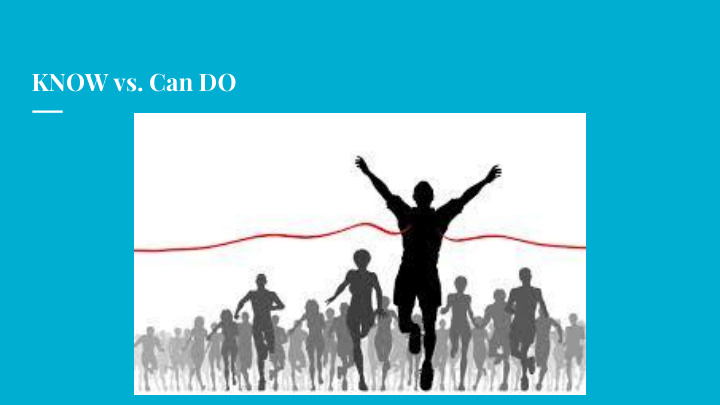



KNOW vs. Can DO
Helping our students Do what they “Know” A little help from the brain But who am I?
Our Map ➢ 3 Brains How is this true? Connection to the body ➢ Kids do well if they CAN ➢ Timeline Private Logic ➢ Behavior IS Information ➢ Growth Edge What is it saying? ➢ Do Calm What does that look like? Classroom Application Loan Calm ➢ ➢ Practice Calm Identify Lagging Skills ➢
“Kids do well if they CAN” Ross Greene How is this true?
The 3 Brain Reason Cortex Limbic Region Brainstem
The KNOW Brain- Cortex Key Concepts- ● Potential /Ready at birth ● Experience creates pathways ○ Fire together, Wire together ● Conscious awareness ● ~5% of behavior ● 25 years to fully develop ● When integrated, regulates subcortical regions
The DO Brain - Limbic Region Key Concepts- ● Functional at birth ● Assessing survival ○ Guides attention ● Emotional center ● Role in learning/memory ● Closed feedback system ● Role in activating- ANS
The DO/BE Brain- Brainstem Key Concepts- ● Mature at full term birth ● Functionally autonomic, involuntary & reflexive Key Architecture- ● Vital organs ● Vagal Nerve ● Most primitive structure
The Body is the Unconscious Mind (~95%) Parasympathetic Sympathetic Relaxed Tense Open Self-protecting Vigilant Interested Exploring Reactive
The Neurobiological Timeline ------------------------------------ 0 2 yrs 5 yrs 15 yrs 25 yrs
At birth, 89 billion single neurons
Kids do well if they CAN Ross Greene What do you now know about the brain that supports this statement? The Cortex Limbic Region/Brainstem The knowing part The doing/being parts Constructed by experience Mature at birth- directs survival ~ 5% of behavior - Conscious ~ 95% of behavior - Unconscious
Let’s Move This “Know”ledge Into the “Do”-ing Brain
Baby Suzy I feel ___________________ I am ___________________ Care-givers are __________ Life is __________________
Baby Joe I feel ___________________ I am ___________________ Care-givers are __________ Life is __________________
Take a few moments- Jot down reactions Who came to mind? Any ah-ha’s? Share
(Mis)Behavior IS Information
“Emotions” are a peptide communication p system that motivates behavior A chain of amino acids = Peptide tryptophan, tyrosine, phenylalanine = Serotonin Candace Pert
Private Logic Neuropathways constructed through experiences before 5 years old. It was adaptive. It makes sense. Learn the story Connect to the logic, validate, and inform
Growth Edge We DO what experience has constructed as a pathway to keep us safe in our most emotionally laden environments Where students are not doing what they “know” a.k.a. The Rules , THAT is where the paved path ends
Classroom APPLICATION So HOW “do” we use this “know”ledge?
First, Understand
Do/Be the Calm Then, integrate your Know, Do brains Self-Care ● Mindfulness Practices ○ Relaxation Practices ○ Self-Awareness ● Identify when you are being hi-jacked into your Do/Be Brain System ○ Know what stress feels like in your body ○ Do your remedies ○ Check your beliefs ○
Loan the Calm Resonance Right to Right
Loan the calm- ASK 1. Am I in my calm? 2. How can I loan my calm? 3. How is this behavior showing me where the pathway ends? 4. Which need is not being met? (yours and the student’s... triggering threat alarms) 5. What skill is lagging? 6. Wonder WITH THE STUDENT about strategies to practice the new/desired behavior?
Loan the calm- Identify the Lagging Skills Ross Greene, Livesinthebalance.org Transition Cognitive Distortion ➢ ➢ Sequencing Social Cues ➢ ➢ Sense of Time Empathy ➢ ➢ Focus Perspective Taking ➢ ➢ Connecting Consequences Sensory/Motor ➢ ➢ Expressing Needs Appropriate Attention Seeking ➢ ➢ Emotional Regulation Multiple Solutions ➢ ➢ Deviating from Rules/ Gray Zone ➢
Practice the Calm ➢ Name it to Tame it ➢ Object Grounding ➢ The Body Scan ➢ Cloud Gazing ➢ Time-In ➢ Shift Happens ➢ Belly Surfing ➢ Develop Common ➢ The Happy Place Language
Develop Common Language
Recap Kids do well if they can Classroom Strategies ➔ ➔ 3 Brain centers Do the calm ◆ ◆ 2 Autonomic Nervous Systems Loan your calm ◆ ◆ Timeline Ask questions ● ◆ Behavior is Information Id. lagging skills ● ➔ Communication System Practice the calm ◆ ◆ Use it ●
Resources & References C ozolino. L. (2013). Social Neuroscience in Education Green, R.W. (2008). Lost at School Green, R. W. www.livesinthebalance.org Harvard University. Center of the Developing Child https://developingchild.harvard.edu Olsen, K. (2013). The Invisible Classroom Pert, C. B. (1997). Molecules of Emotion. The science behind mind-body medicine. Siegel, D. (2013). Brainstorm: the Power of the Teenage Brain Souers, K. & Hall, P. (2016). Fostering Resilient Learners
Recommend
More recommend